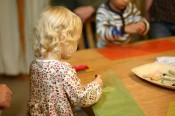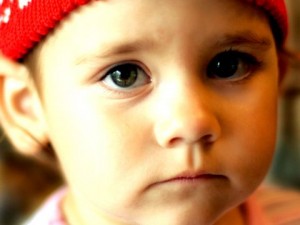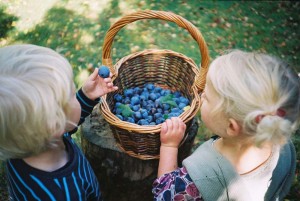Waldorf News
Resilience by Christof Wiechert

Disturbing reports are circulating around the world, always in the murky twilight of so-called ‘facts.’ According to the rumors, or indeed facts, that we are dealing with, a disproportionate number of war veterans commit suicide on their return to the USA from their tour in Iraq. After the Vietnam War, accounts came in from various sides of how soldiers were able to cope again with everyday civilian life only with great effort. People in Europe are also worried about the NATO soldiers’ ability to deal with trauma when they are in peace-keeping missions abroad. The question is, How does an individual cope with traumatic or otherwise shattering events in his or her life? This question is just as valid for children as for adults.
The research that deals with this is research into resilience—research into the overcoming, the processing of, ‘insurmountable’ experiences, research into the sours (mental) power of resistance (resilire = to spring back, to rebound).
This research began after World War II, when people were faced with the fact that there were those who inwardly overcame their experiences of war or prison and were able to resume a ‘normal’ life once their soul wounds were healed. However, at the same time, they realized that there were those who never really overcame these experiences and instead kept suffering from the trauma affecting them.

The question arose on what this ability to inwardly overcome experiences depends. What makes one child strong in taking life’s knocks, what makes another child react so much more sensitively? From regions where people have been hit by great natural disasters, we hear relatively little of the problems that they have in inwardly coming to terms with them.
Research into resilience has arrived at several conclusions that have considerable significance for educators in particular. The first issue was to follow up on the question of whether the soul’s power of resistance may be explained by heredity. If the parents have inner strength, is it passed on to their offspring? After numerous studies the conclusion was reached that this is not the case. Resilience is not inherited.
However, resilience is definitely connected with the experiences of the early years of childhood. One researcher thinks it is a matter of the first four or five years, while another thinks the whole time of childhood is significant, that is, until the tenth year. Leaving aside the different viewpoints, there is agreement that the soul’s power of resistance, or resilience, is nurtured and developed, if children have had the following five experiences.
A reliable, stable relationship with one person
This person does not necessarily need to be the mother, but it is necessary for it to be a single person in the beginning. Later on this person may be joined by others. Neurologists also point out that at the start of life there must be only one person to relate to. Later on, there may be a second, followed by a third or fourth person, who is added to the circle of people the child relates to, but just not in the beginning.
The growing child needs the experience of an authoritative upbringing
This means that the child needs the fundamental experience that others (involved in its upbringing) decide for him/her, and that he/she is completely relieved of the necessity of making decisions, It is simply from the experience that others make the right decisions that the child gains a sense of security in life, in other words, trust. This experience cannot be estimated too highly. In the first place, others decide what is good or bad for me, what is right and wrong, healthy and unhealthy. A deep feeling of security comes about: I can leave it up to the world to take over; I can rely upon my surroundings in all circumstances.
Children need the experience of learning through example
This has to do with two qualities, firstly, a moral quality that makes a deep impression: What the child experiences through the example of the behavior of those around him should be completely compatible with what is demanded of him. If the child is forbidden to watch television and the people he relates to watch unlimited amounts of television, the child’s understanding of his surroundings as a totality cracks open. You can add many other examples.
There is something else at stake too. When the Canadian psychologist Albert Bandura discovered the mirror neurons and their activity in human beings, the interesting question arose as to whether, in general, the child learns with his/her intellect or from imitation, from “doing it like this too.” Bandura argues vehemently that the young child learns from imitating, not through cognition, something he documents impressively through the process of learning to speak.
To date, in the practice of teaching, this most significant idea, the idea that children learn in a more carefree way through imitation rather than laboriously drumming things into their heads, is scarcely to be found. In this case we are talking about children up to the age of ten. Through the process of a child’s learning, for example, to do arithmetic by developing habits rather than through the intellect, self-confidence is developed as he learns ‘externally’; he feels affirmed through the sure habit.
The research described here does not derive from an anthroposophical-anthropological milieu, but from conventional research. It is, therefore, legitimate to emphasize that, according to Steiner, from around the twelfth year cognitive learning takes on more and more significance. Only with Steiner is this whole complex called “becoming capable of forming judgments.” In other words, the learning process is guided and determined by the child’s own power of discrimination, no longer by habit.
 Children need a qualitative experience of time
Children need a qualitative experience of time
What is the difference between morning and evening for our feeling about life? What is the difference between autumn and spring, summer and winter for our feeling about life? Within a Christian context, how does the Easter festival differ from Christmas? Or within an Islamic context, how does the sugar festival differ from the beginning of Ramadan? How does the child experience the ordering of time, how do we help him to experience the ordering of time? Here is one quite simple example: when I was still quite young, people in Holland celebrated the Queen’s birthday at the end of spring. This was the season when we used to visit the annual fair and celebrate the day we would be given cotton candy on a wooden stick. In our minds as children this cotton candy developed into the quintessence of the celebration of the Queen’s birthday. Lots of biographies describe rituals that are linked to the seasons. There is also the simple fact of going to bed. Is it a random activity because we are tired, or is there a small ritual belonging to this moment when we take our leave of the day that is entirely different from waking up in the morning?
We can see from the way in which this fact is reflected in Waldorf kindergartens and schools that these festivals are not celebrated just for the sake of it, but rather out of some insight. Whoever wants to give shape to his or her life, whoever refuses to be ‘lived’ has to shape time.
The child needs a definite surplus of positive school experiences
The fifth condition from research into resilience scarcely requires an explanation, Nonetheless, it ought to be pointed out that for long periods of time (times which are not yet over) the question whether pupils are left with more positive than negative experiences from learning, from going to school, is considered incidental. This needs to be seen properly. Many school traumas will accompany the individual for his or her whole life, wounds of which the school (or the teachers) are often not aware. If they were aware of them, the schools would set things up differently. In other words, whatever basis is laid down for the mood of soul at school plays a key role in the memory of individuals for their lives. This is an important reason for schools and teachers to ask themselves how the pupils are faring. This is by no means to deny that school is a place where pupils can go through a crisis; this will also need to happen. What is at stake is the overcoming of difficulties and whether pupils feel sufficiently accepted by the teachers.
We will have no difficulty, after reading the above account, in establishing the basic requirements of the art of education. That is to say, the art of education is based on resilience. We are dealing with one aspect of resilience. Another aspect is concerned with the so-called education for dealing with emergencies. How do we help children who have survived natural disasters or war disasters? Nowadays, we know that what enables children to work through trauma more than anything else is art or artistic activity. (This can be gleaned from the Chengdu Waldorf school report.) This fact has been documented in lots of places and it confirms the healing power that can come from art. Art needs to become a normal part of every form of education.
Christof Wiechert served as the head of the Pedagogical Section of the School of Spiritual Science at the Goetheanum in Dornach, Switzerland from 2000-2010. His task was to encourage, advise, and inspire Waldorf educators around the world. He did this with great energy, wisdom, insight, and humor. During his tenure, Christof Wiechert visited North America many times, lecturing at conferences, giving workshops, visiting schools and teacher education institutes. At the end of 2010, Wiechert retired as head of the Pedagogical Section, although he remains in Dornach and continues his work for Waldorf Education.
“Research into Resilience” by Christof Wiechert is from the Waldorf Journal Project #17: From Images to Thinking © AWSNA Publications/David Mitchell and is reprinted here with their kind permission.

 Apply Today: New Cohort Starts Nov. 2025
Apply Today: New Cohort Starts Nov. 2025 Bringing Love to Learning for a Lifetime
Bringing Love to Learning for a Lifetime Middle School Science With Roberto Trostli
Middle School Science With Roberto Trostli Flexible preparation for your new grade
Flexible preparation for your new grade Summer Programs - Culminating Class Trips
Summer Programs - Culminating Class Trips Space speaks. Its language is movement.
Space speaks. Its language is movement. ~ Ensoul Your World With Color ~
~ Ensoul Your World With Color ~ Storytelling Skills for Teachers
Storytelling Skills for Teachers Waldorf EC Training & Intensives in Canada
Waldorf EC Training & Intensives in Canada Grade Level Training in Southern California
Grade Level Training in Southern California Everything a Teacher Needs
Everything a Teacher Needs Art of Teaching Summer Courses 2025
Art of Teaching Summer Courses 2025 Quality Education in the Heartland
Quality Education in the Heartland Caring for All Stages of Life
Caring for All Stages of Life Jamie York Books, Resources, Workshops
Jamie York Books, Resources, Workshops Roadmap to Literacy Books & Courses
Roadmap to Literacy Books & Courses Association for a Healing Education
Association for a Healing Education The Journey is Everything
The Journey is Everything Waldorf-inspired Homeschool Curriculum
Waldorf-inspired Homeschool Curriculum Transforming Voices Worldwide
Transforming Voices Worldwide Immersive Academics and Arts
Immersive Academics and Arts Bay Area Teacher Training
Bay Area Teacher Training Full-Time Teacher Education
Full-Time Teacher Education Train to Teach in Seattle
Train to Teach in Seattle RSS Feeds
RSS Feeds